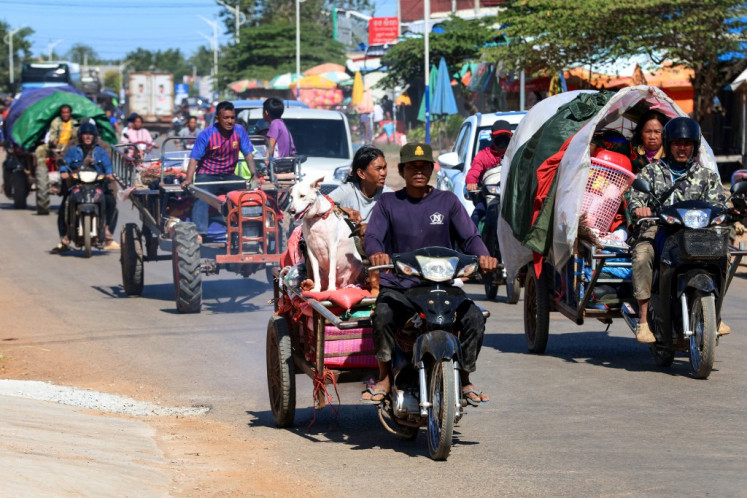Popular Reads
Top Results
Can't find what you're looking for?
View all search resultsPopular Reads
Top Results
Can't find what you're looking for?
View all search resultsCandra Naya, besieged but still charming
Preserved: Candra Naya mansion on Jl
Change text size
Gift Premium Articles
to Anyone
P
span class="caption">Preserved: Candra Naya mansion on Jl. Gajah Mada in West Jakarta still has its old charm although it is surrounded by high-rise buildings.(JP/Seto Wardhana)
Besieged amid a towering business center on Jl. Gajah Mada in West Jakarta, what is left of Candra Naya mansion still emanates its old charm, evoking a nostalgic mood among visitors.
The former mansion of a Chinese mayor, Candra Naya is surrounded by four 21st century towers, a superblock called Green City Center, consisting of a Novotel hotel, an apartment, office building, restaurants and banks.
Nevertheless, the large Chinese door, curved brick roof, the swaying red lampions and Chinese calligraphy give the historical building a charming facade.
The smaller front building of the house had been the only building left intact, but after much protest from the heritage society and historians, the developer rebuilt the wing buildings, which were dismantled in the 1990s to make way for heavy equipment used for constructing modern commercial buildings.
The original structure was a 615 square-meter main two-story building, two 1,051-sq m wings and a 118-sq m gazebo. The two-story building has not been rebuilt.
'The place is unique; a building from the 19th century densely surrounded by modern buildings from the 21st century,' said Ester Christine Natalia, one of the visitors who learned of the site from her friend and through the Internet. 'It is quite interesting for a passerby.'
The site, a source of heated heritage and historical debate for years, has been developed into a commercial superblock, launched in 2012. Green Central City, managed by Modernland Realty's PT Bumi Perkasa Permai, has promoted the existence of Candra Naya in its strategy to market the apartments.
Through 2011 to 2013, the management has told potential buyers the site is the land of prosperity because Candra Naya was owned by a wealthy man.
Candra Naya was built in the 19th century as the house of Khouw Kim An, the last Chinese mayor in Jakarta, or Batavia. Later, the building became the center for a Chinese social and educational organization called Sin Ming Hui after the mayor died in 1946. In 1957, the name was changed to Candra Naya after the government required all foreign names to be changed to Indonesian.
The building, which has been owned by Modern Group since 1992, was to be relocated to the Indonesian Miniature Park (TMII) in East Jakarta but former Jakarta governor Sutiyoso rejected the plan.
The smaller front building has been restored and conserved while the new wing buildings house restaurants. The management also offers the site to people who want to commemorate cultural events such as Chinese New Year.
The two-story, large building, which was a personal area for the mayor and his family, is no longer standing, according to Candra Naya conservation chief, Naniek Widayati. 'The logs, however, are kept in the warehouse of the business center.'
Naniek said Modernland Realty fully funded the conservation program with its social funds. She denied it funded the mansion with funds from renting the wings.
She added that none of the funds came from the Jakarta government.
Separately, prominent historian JJ Rizal, regretted the issuance of permits in the 1990s by the government to a number of developers, as doing so allowed them to build a business center around historical sites such as Candra Naya and Pondok Cina in Depok, West Java.
He considered what most developers did to the sites an 'amputation' of Indonesia's intercultural symbols.
'If Candra Naya was a human, what they did to it is actually an amputation. They cut the hands, legs and others. Then, they left only the heart,' said Rizal. 'The backyard, garden, path and any other feature connects the story between the site and its surroundings. What is mostly left now is only the heart, the building.'
To conserve historical sites, Rizal suggests the administration make the sites, including their ecological environment, new tourist areas.
'Currently, Ahok and his administration have been acquiring many plots of land for public areas. I wonder -why they don't just buy historical sites and their surrounding areas so they can be used by the public?'










